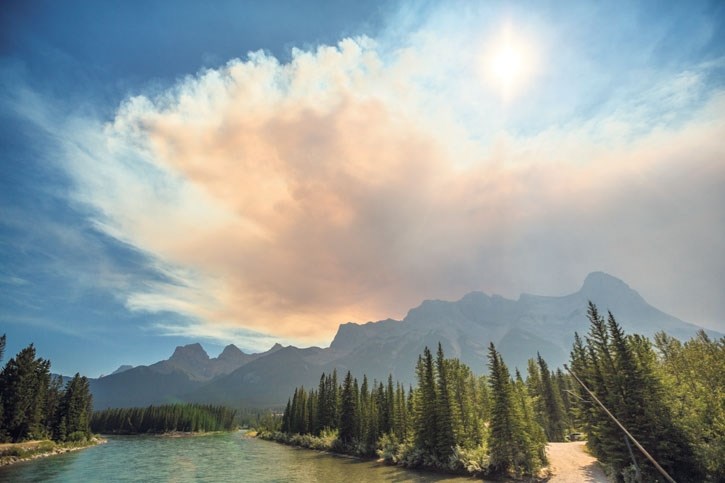BANFF – People will have to die before wildfire policies are changed.
That was the blunt and ominous message journalist and author Edward Struzik delivered during a discussion last Thursday (April 5) about the growing wildfire risk communities such as Banff and Canmore face.
“My fear is that it’s going to take a fire that kills a lot people to make something big happen and I think that’s really unconscionable,” said Struzik, author of Firestorm: How Wildfire Will Shape Our Future.
His highly acclaimed book, which looks at wildfires from Alaska to Maine, makes the case for a radically different approach to managing wildfire in the 21st century and argues wildfires can no longer be treated as avoidable events because the risk and dangers are simply too great.
“We have a lot of false expectations about how we can deal with wildfire,” said Struzik, adding it will take a cultural shift in the way we think about wildfires if we want to avoid a major catastrophe.
He warned that the number of wildfires are expected to jump anywhere from 74 to 118 per cent this century, with some experts projecting the number of wildfires could triple, or even quadruple. Currently there are 9,000 wildfires annually in Canada.
To get his message across he highlighted dozens of catastrophic wildfires that have occurred over the past century across North America, including the 2016 wildfire in Fort McMurray, which forced more than 88,000 people to flea their homes at the last minute.
“Big fires can’t be stopped,” said Struzik bluntly. “In the firefighting world that’s pretty much unanimous. Once it gets to a certain size, it’s debateable whether it’s 200 hectares or 1,000 hectares, there’s little you can do. You can drop retardants on it, you can hit it with an army of firefighters, but the best thing you can do in most cases is slow the fire or change its direction, but you can’t stop it.”
He said it’s impossible to stop large wildfires because they can have “atomic bomb-like energy” that can create their own weather including lightening and tornados.
“The other reason why we’re delusional is if we think that we can fight every fire and rely on our firefighters to deal with these situations, mega fires can move fast.”
He said 60 per cent of all cities, towns and settlements across Canada are vulnerable to wildfire, particularly First Nation communities.
“Right now they represent just four per cent of the population, but 40 per cent of evacuations that take place in Canada. There’s something really wrong with that picture,” said Struzik.
During the question and answer period he criticized the provincial and federal levels of government for failing to take any meaningful actions to reduce the risk and better prepare communities in the event of a major fire.
“Part of the problem, as I keep repeating, is that after the 2003 fires, the B.C. government hired Gary Filmon, the former premier of Manitoba, to come up with an action plan. They didn’t follow up on it. Then the Canadian Council of Forest Ministers got together in 2005 to come up with an action plan and nobody did anything about it. In 2008 they got together again, updated the plan and still we’re not doing anything about it.”
Closer to home the municipalities of Canmore and Banff have taken a more proactive approach updating wildfire risk zone maps to make sure future development and landscaping takes the threat of wildfire into account.
While that’s a good first step, Struzik said more will need to be done to mitigate the risk including spending more resources on wildfire suppression.
Currently, Canada spends $800 million annually to fight wildfires, however in recent years that number has exceed $1 billion and it’s projected to double to keep up with fires that are going to burn bigger and more often in the future.
He also suggested that there needs to be better early warning systems, similar to Tsunami and Tornado warning systems that are already in place.
“We have hurricane warnings, tornado warnings and tsunami warnings. Why? Because they are meteorological events that we know can’t be stopped. We have to start looking at wildfires as a meteorological event that can’t be stopped so we have better early warning systems.”
Among his other suggestions he argued there needs to be a line drawn in the sand that would automatically begin evacuation plans as soon as a fire crossed that line.
He also suggested the government needs to invest more in emergency response, public education and new building and landscaping guidelines.
“We spend an awful lot of money on energy efficient homes. Why don’t we have a fire resiliency program that encourages people with subsidies to do the things that make their homes more resilient?” said Struzik.
“We’d save just as much money and probably an awful lot more and it would give people the incentive, people that might not be able to afford it, to do the things that are necessary to keep their home protected.”
He said part of the solution also includes more fire breaks around communities, FireSmart work and controlled burns, along with allowing natural fires started by lightening to burn in remote areas.
He credited Parks Canada for its FireSmart work and it prescribed burns over the years, however he urged the audience to push their politicians to do more rather than railing against the federal agency.
“Don’t ask Parks Canada, because Parks Canada I think to some extent is handcuffed between what the policy makers say and what the public wants,” said Struzik.
“The people that you need to get to are the people you elect and if enough pressure is put on them, they’re going to give Parks Canada the resources and the social licence to do what they have to do.”




